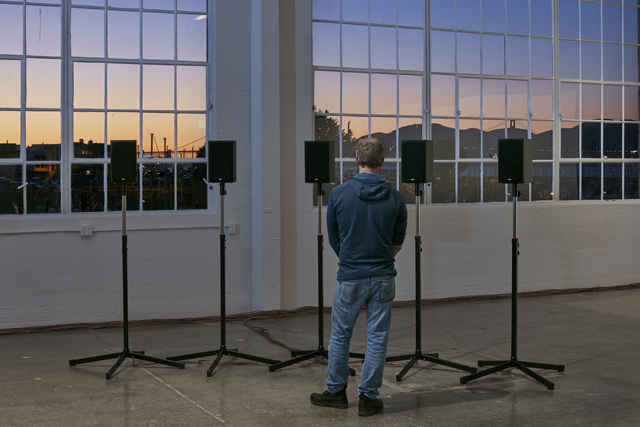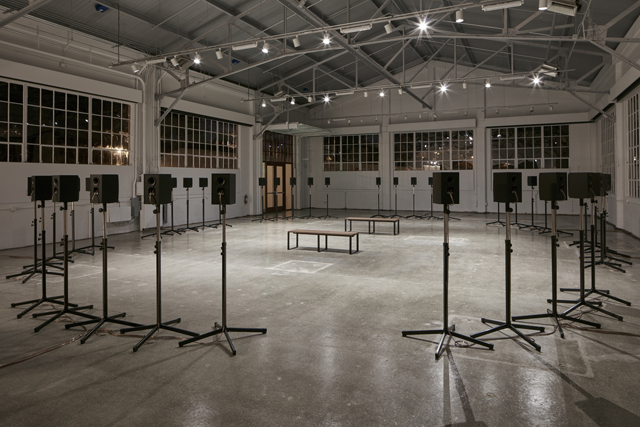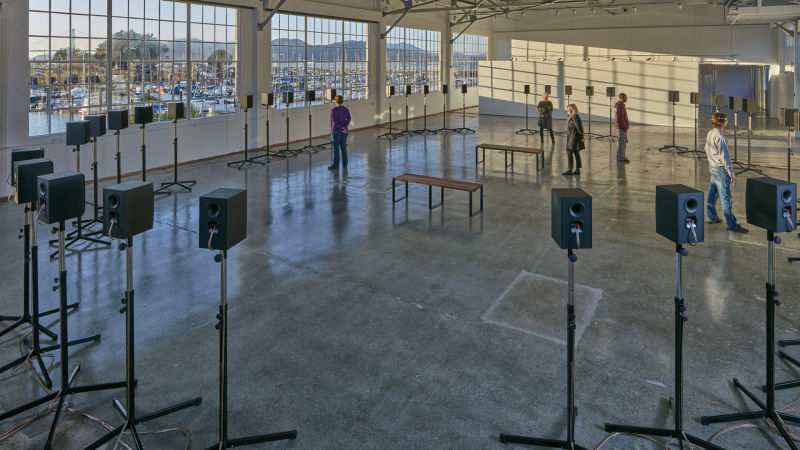It’s hard to write about Janet Cardiff’s sound installation The Forty Part Motet without devolving into superlatives. Previous installations in New York at PS1 and the Cloisters garnered reviews that included the words “achingly beautiful” and “transcendent.” These aren’t, in my opinion, overstatements. But pulling together a list of adjectives about The Forty Part Motet is far easier than trying to explain how and why the work is so compelling. Here goes.

2015. (Photo: JKA Photography)
Cardiff’s piece is an intimate affair: an oval of 40 black speakers on stands, arranged at ear height and grouped in eight clusters of five speakers, all facing the center of the room. The newly renovated gallery 308 at Fort Mason Center is spare and stripped down, with one wall of windows overlooking Gashouse Cove and the gently swaying masts of boats in the marina. Upon entering the airy room, visitors hear the soaring sounds of English Renaissance composer Thomas Tallis’ 1573 choral work Spem in alium nunquam habui (I have never put my hope in any other).
Inside the oval of speakers, the quality of sound changes dramatically. As voices rise and fall, sound moves throughout the ring, giving the musical arrangement shape and mass. Cardiff recorded each voice in the polyphonic 40-part composition individually; each speaker represents one member of the Salisbury Cathedral Choir. Stand close to a speaker to focus on one singer’s voice, step back to the middle for the intermingled audio of the choir as a whole. “I wanted to be able to ‘climb inside’ the music, connecting with the separate voices,” Cardiff says via the installation’s wall text.
The Latin lyrics, sung in crystalline soprano, alto, tenor, baritone and impossibly deep bass, sing to a God “who can show both anger and graciousness.” While only classics scholars might have any hope of comprehending the words of Spem in alium today, the arrangement is undeniably spiritual.
“I knew it was a piece that was written in a religious context, like a lot of music then, but I really did not know that it would have the kind of effect that it has on a lot of people,” Cardiff said at yesterday’s press preview. At moments when all 40 members of the choir sang together, like the instruments of a heavenly orchestra rather than mere mortals with vocal chords, shivers ran down my spine.

2015. (Photo: JKA Photography)
The others in Gallery 308 responded to the music in different ways. The Forty Part Motet triggers emotional responses rarely seen in the sterile world of contemporary art. Some of my fellow listeners turned inward, their eyes open but unseeing; some walked slowly around the oval of speakers, stopping to experience each voice. Some closed their eyes and abandoned themselves to wash of sound. As an external soundtrack, the piece turns a pleasant but unremarkable view of the marina into something like an ecstatic experience.


